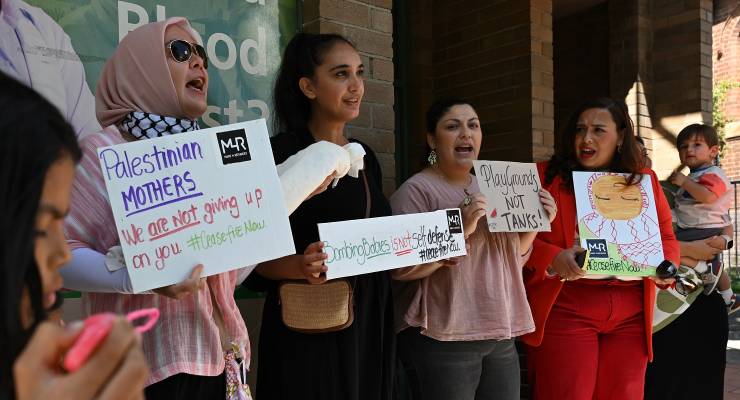
Doth protest too much?
There is a protest outside Prime Minister Anthony Albanese’s office, currently in its third week, demanding he do more to bring about an end to the horrors in Gaza. It has received scarcely a moment of coverage in the News Corp or Nine papers, which got us in the bunker thinking: when does an anti-Labor protest get attention, and when doesn’t it?
- There was widespread reporting on anger at the Andrews government over Melbourne’s lockdown. Some of it was undertaken with such haste that key details were somehow omitted — say, that Andrew Abercrombie, the “business leader” leading a group pushing the state to open was not only a former Victorian state Liberal Party treasurer but also among the group who brought the virus into the state from Aspen.
- Dissent over Labor’s proposed franking credits got weeks of coverage in the lead-up to the 2019 election with front-page stories, photos of “concerned citizens” peering out from their seaside properties and people declaring they might as well be euthanised. None of the potential conflicts of interest behind this protest stopped dozens of largely sympathetic stories.
- And of course, the protest against the imposition of a carbon price, particularly the rally outside Parliament in March 2011, was written about for months in the mainstream press — a look through Factiva shows it was mentioned in the News Corp papers 25 times in the week after it happened, and 64 times by the end of the year.
Carbon tax protesters even showed up at Albanese’s office that year — he wasn’t even prime minister at this point, but it was still covered in the ABC, the Oz, The Daily Telegraph and The Sydney Morning Herald. So what is it about this most recent bout of sustained public fury at Labor that makes it so unworthy of attention?
Fordhamming it up
But here’s a potential controversy that media figures will spend some of their one and only go at life talking about: flag placement. 2GB host Ben Fordham looked askance at Albanese’s platform during his message of solidarity with Ukraine, to mark the second anniversary of Russia’s invasion.
Not because, say, it called attention to the exemplary way Australia helped ensure international law was upheld in response to Russia’s actions (as opposed to our equivocation over the Israeli military’s conduct in Gaza)? Nope, it was because the Australian flag was directly behind Albanese and thus slightly obscured (but also absolutely visible).
Assange and the NYT
We noted with some interest The New York Times‘ report on CIA support for Ukraine. It’s a well-sourced article which we’d venture doesn’t contain much that would outrage US intelligence services, revealing the high-level training and equipment the CIA provides its Ukrainian equivalent, the SBU and concluding “the intelligence partnership between the United States and Ukraine is a linchpin of Ukraine’s ability to defend itself”.
“Without them, there would have been no way for us to resist the Russians, or to beat them,” former head of Ukraine’s domestic intelligence agency Ivan Bakanov gratefully notes. We only mention it because of the NYT’s near silence (long noted in these pages) on Julian Assange’s current situation; even a recent piece defending Assange on principle dedicates roughly half its words to what an unworthy and loathsome character he is. At one time, Assange and NYT partnered up to reveal uncomfortable truths about US statecraft. That tone seems to have shifted a great deal since.
CPAC it in
Earlier this year we speculated about the very specific kind of young person seduced by the chance to breathe in the heady and no doubt COVID-clogged air of the Conservative Political Action Conference (CPAC), after the Australian CPAC branch offered under 25s the chance to accompany them to the Lollapalooza of reactionary politics. We could only think of 24-year-old Sky News columnist Caleb Bond.
We forgot about Barclay McGain — and of course the prolific edgelord and former staffer for noted empath Andrew Laming was there, cropping up in a bunch of CPAC’s pics of the event on Facebook:

CPAC Australia head Andrew Cooper grabbed a pic with former (technically) UK PM Liz Truss, who was presumably there trying to find replacements for all the people who quit her “PopCons” group before it started:

And if Truss’ enthusiasm for pork markets doesn’t appeal to you, CNN has noted some other people you could hang out with:
At the Young Republican mixer Friday evening, a group of Nazis who openly identified as national socialists mingled with mainstream conservative personalities, including some from Turning Point USA, and discussed “race science” and anti-Semitic conspiracy theories.
One member of the group, Greg Conte, who attended the deadly 2017 Unite the Right rally in Charlottesville, Virginia, said that his group showed up to talk to the media. He said that the group was prepared to be ejected if CPAC organisers were tipped off, but that never happened.
Another, Ryan Sanchez, who was previously part of the Nazi ‘Rise Above Movement’, took photos and videos of himself at the conference …
It hardly seems worth mentioning, but star of the show Donald Trump’s speech was troubling in a way so familiar it barely seems to register anymore.








Crikey encourages robust conversations on our website. However, we’re a small team, so sometimes we have to reluctantly turn comments off due to legal risk. Thanks for your understanding and in the meantime, have a read of our moderation guidelines.